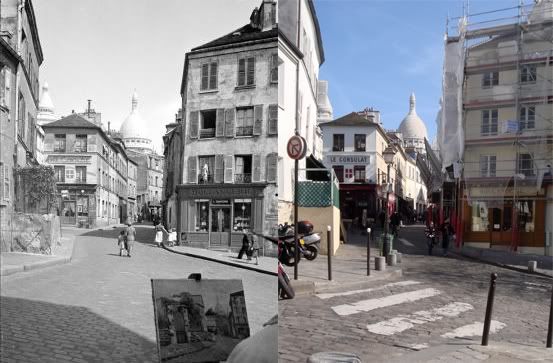 1909-2009
1909-2009There is perhaps no neighborhood of Paris that is as legendary as Montmartre. Formerly an autonomous town on a hilltop overlooking the city, the neighborhood, at least in its built form, still retains much of its village charm. The working class quarter had a violent coming-of-age when it played a pivotal role as a center of socialist resistance during the bloody Paris Commune of 1871. In the decades that followed, Montmartre became the epicenter of gritty Parisian bohemia, home to caf
és and cabarets notorious for their debauchery, including the Chat Noir and the Moulin Rouge. Then there were the scores of artists that followed - giants like Renoir, Monet, van Gogh, Derain, Toulouse-Lautrec, and Picasso. By the eve of the Great War, the slopes of Montmartre had obtained an undeniably monumental place in the pantheon of Parisian mythology.
And then came the foreigners, beginning with the trickle of American sailors looking for a good time after the war, a trickle which grew steadily alongside the burgeoning international tourism industry. Today's Montmartre would be shockingly unrecognizable to the workers, whores, and artists who lived there a century ago. All year round, the streets are packed with crowds of tourists and the conmen and thugs after their money. In its main square, la place du Tertre (pictured at top), painters and caricature artists peddle largely generic and touristy ware. Among the caf
é tables adjoining the square, curiously coustumed waiters serve some of the city's most expensive caf
é expressos.
All told, Montmartre is hardly more than a shell of its former self. Bohemia came and went, and took with it its sordid and electric mystery, whose legend nonetheless continues to draw thousands to the mount that has loomed over Paris for centuries. In a way, Montmartre merely traded its licentious vulgarity for vulgarity of another kind - tourist kitsch. Nonetheless, this does nothing to reduce the huge sense of loss to be felt. I don't believe that Paris should be left for only Parisians to enjoy, nor that neighborhoods should not change. Yet I cannot help but feel that there is something deeply sad about the whole affair, and that this is in some sense, one of the most tragic stories of Paris' 20th century history.
Original photo: "RV-317344." 1909. Collection Maurice Branger/Roger-Viollet. Parisenimages.fr. Parisienne de Photographie. 18 Mar. 2009. http://www.parisenimages.fr/Export450/2000/1641-4.jpg
 c. 1950-2009
c. 1950-2009 c. 1950-2009
c. 1950-2009 1948-2009
1948-2009
 The former railway station has been receded several hundred meters southward and is no longer visible in the original view, replaced by the Galeries LaFayette shopping center and the Tour Montparnasse.
The former railway station has been receded several hundred meters southward and is no longer visible in the original view, replaced by the Galeries LaFayette shopping center and the Tour Montparnasse. As if its cosmpolitan vigor, wonderful climate, and rich architectural heritage weren't enough, Barcelona boasts an unparalleled collection of historic street lamps, without which the city's beauty wouldn't be quite the same.
As if its cosmpolitan vigor, wonderful climate, and rich architectural heritage weren't enough, Barcelona boasts an unparalleled collection of historic street lamps, without which the city's beauty wouldn't be quite the same. Their design is nothing to be scoffed at. The lampposts of the Plaça Reial, pictured at top, were in fact the first official commission of Antoni Gaudí, who quickly went on to become the shining star of Catalan Modernism and one of Barcelona's most celebrated figures.
Their design is nothing to be scoffed at. The lampposts of the Plaça Reial, pictured at top, were in fact the first official commission of Antoni Gaudí, who quickly went on to become the shining star of Catalan Modernism and one of Barcelona's most celebrated figures. Interestingly, the city's fondness for unique street lighting lasts to this day, and many of its contemporary street lights seem to have preserved this spirit. For example, take the raw sculptural poles along the Grand Via de Carlos III.
Interestingly, the city's fondness for unique street lighting lasts to this day, and many of its contemporary street lights seem to have preserved this spirit. For example, take the raw sculptural poles along the Grand Via de Carlos III. Links and sources:
Links and sources: